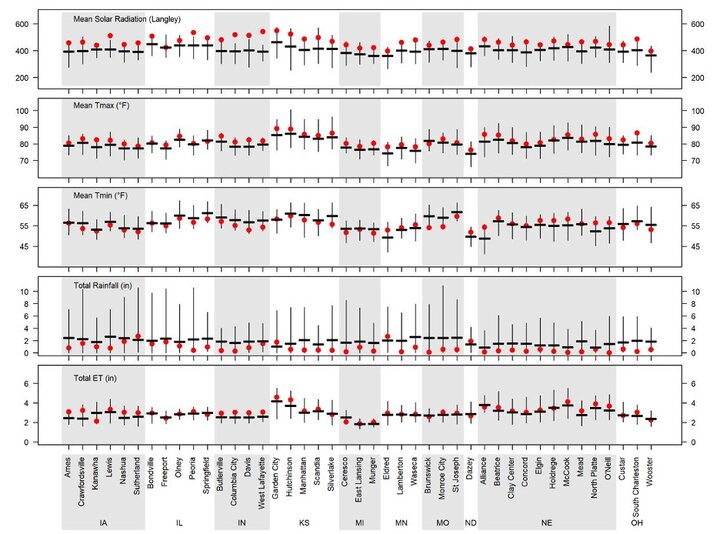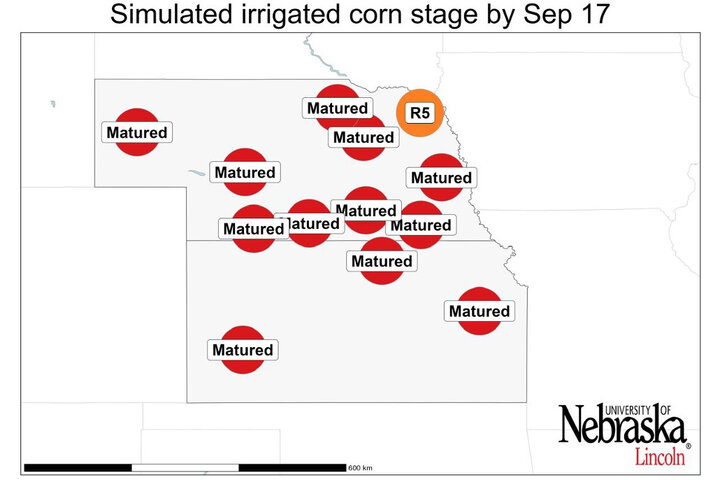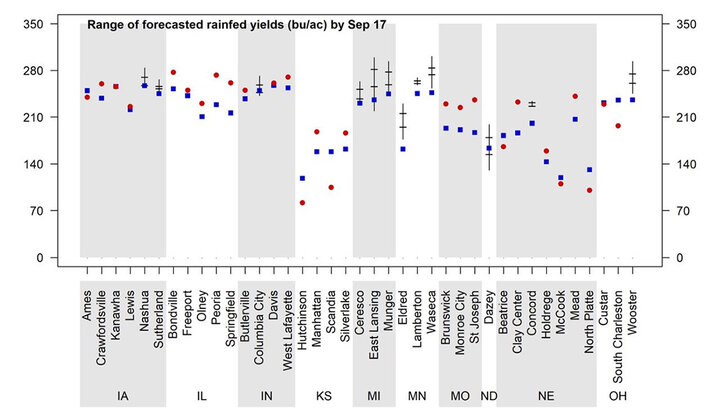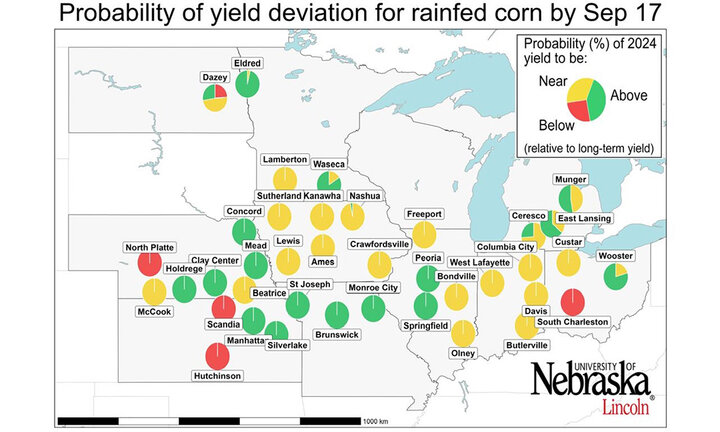This is the last article in a series that summarizes the simulated crop stages and yield forecasts across the Corn Belt. To evaluate, in “real-time,” the impact of this season’s weather on corn yield and its spatial variability across the Corn Belt, simulations of 2024 real-time crop stage were performed for 43 locations across the U.S. Corn Belt using the UNL Hybrid-Maize crop model; the data can be seen in Table 1. Details on the UNL Hybrid-Maize crop model and the underpinning methodology to simulate phenology and forecast end-of-season yields is described in a previous article.

| Location | Water regime | Long-term average yield (bu/ac) § | Range of Yp forecasts as of Sep 16 (bu/ac)¶ 25th | Range of Yp forecasts as of Sep 16 (bu/ac)¶ 75th | Probability (%) of 2024 yield to be: Below (relative to the long-term Yp)† | Probability (%) of 2024 yield to be: Near (relative to the long-term Yp)† | Probability (%) of 2024 yield to be: Above (relative to the long-term Yp)† | Simulated current crop stage* | |
|---|---|---|---|---|---|---|---|---|---|
| NE | Alliance | Irrigated | 230 | Black layer on Sept. 8. Final yield: 241 bu/ac | Matured | ||||
| Beatrice | Dryland | 183 | Black layer on Aug. 24. Final yield: 166 bu/ac | Matured | |||||
| Irrigated | 241 | Black layer on Aug. 26. Final yield: 237 bu/ac | Matured | ||||||
| Clay Center | Dryland | 186 | Black layer on Sept. 8. Final yield: 232 bu/ac | Matured | |||||
| Irrigated | 258 | Black layer on Sept. 8. Final yield: 263 bu/ac | Matured | ||||||
| Concord | Dryland | 201 | 226 | 232 | 0% | 0% | 100% | R5, Dent | |
| Irrigated | 268 | 279 | 285 | 0% | 43% | 57% | R5, Dent | ||
| Elgin | Irrigated | 268 | Black layer on Sept. 15. Final yield: 260 bu/ac | Matured | |||||
| Holdrege | Dryland | 143 | Black layer on Sept. 3. Final yield: 159 bu/ac | Matured | |||||
| Irrigated | 257 | Black layer on Sept. 9. Final yield: 263 bu/ac | Matured | ||||||
| McCook | Dryland | 119 | Black layer on Aug. 28. Final yield: 110 bu/ac | Matured | |||||
| Irrigated | 238 | Black layer on Aug. 31. Final yield: 239 bu/ac | Matured | ||||||
| Mead | Dryland | 206 | Black layer on Sept. 4. Final yield: 241 bu/ac | Matured | |||||
| Irrigated | 247 | Black layer on Sept. 4. Final yield: 256 bu/ac | Matured | ||||||
| North Platte | Dryland | 131 | Black layer on Sept. 9. Final yield: 100 bu/ac | Matured | |||||
| Irrigated | 256 | Black layer on Sept. 13. Final yield: 252 bu/ac | Matured | ||||||
| O'Neill | Irrigated | 247 | Black layer on Sept 14. Final yield: 253 bu/ac | Matured | |||||
| IA | Ames | Dryland | 250 | Black layer on Sept. 10. Final yield: 240 bu/ac | Matured | ||||
| Crawfordsville | Dryland | 238 | Black layer on Sept. 9. Final yield: 260 bu/ac | Matured | |||||
| Kanawha | Dryland | 256 | Black layer on Sept. 15. Final yield: 255 bu/ac | Matured | |||||
| Lewis | Dryland | 221 | Black layer on Sept. 6. Final yield: 226 bu/ac | Matured | |||||
| Nashua | Dryland | 257 | 257 | 270 | 0% | 97% | 0% | R5, Dent | |
| Sutherland | Dryland | 245 | 253 | 256 | 0% | 100% | 0% | R5, Dent | |
| IL | Bondville | Dryland | 252 | Black layer on Sept. 11. Final yield: 277 bu/ac | Matured | ||||
| Freeport | Dryland | 242 | Black layer on Sept. 15. Final yield: 250 bu/ac | Matured | |||||
| Olney | Dryland | 210 | Black layer on Aug. 27. Final yield: 230 bu/ac | Matured | |||||
| Peoria | Dryland | 228 | Black layer on Sept. 10. Final yield: 273 bu/ac | Matured | |||||
| Springfield | Dryland | 216 | Black layer on Aug. 30. Final yield: 261 bu/ac | Matured | |||||
| IN | Butlerville | Dryland | 237 | Black layer on Sept. 3. Final yield: 250 bu/ac | Matured | ||||
| Columbia City | Dryland | 250 | 247 | 259 | 0% | 100% | 0% | R5, Dent | |
| Davis | Dryland | 257 | Black layer on Sept. 12. Final yield: 261 bu/ac | Matured | |||||
| West Lafayette | Dryland | 254 | Black layer on Sept. 6. Final yield: 270 bu/ac | Matured | |||||
| KS | Garden City | Irrigated | 237 | Black layer on Aug. 19. Final yield: 225 bu/ac | Matured | ||||
| Hutchinson | Dryland | 118 | Black layer on July 30. Final yield: 82 bu/ac | Matured | |||||
| Manhattan | Dryland | 158 | Black layer on Aug. 13. Final yield: 188 bu/ac | Matured | |||||
| Scandia | Dryland | 158 | Black layer on Aug. 17. Final yield: 104 bu/ac | Matured | |||||
| Irrigated | 234 | Black layer on Aug. 26. Final yield: 247 bu/ac | Matured | ||||||
| Silverlake | Dryland | 162 | Black layer on Aug. 13. Final yield: 186 bu/ac | Matured | |||||
| Irrigated | 218 | Black layer on Aug. 17. Final yield: 228 bu/ac | Matured | ||||||
| MI | Ceresco | Dryland | 231 | 238 | 252 | 0% | 74% | 26% | R5, Dent |
| East Lansing | Dryland | 236 | 256 | 282 | 0% | 36% | 64% | R5, Dent | |
| Munger | Dryland | 245 | 259 | 278 | 0% | 47% | 53% | R5, Dent | |
| MN | Eldred | Dryland | 162 | 196 | 216 | 0% | 4% | 96% | R5, Dent |
| Lamberton | Dryland | 245 | 261 | 264 | 0% | 100% | 0% | R5, Dent | |
| Waseca | Dryland | 246 | 274 | 284 | 0% | 16% | 84% | R5, Dent | |
| MO | Brunswick | Dryland | 194 | Black layer on Aug. 22. Final yield: 229 bu/ac | Matured | ||||
| Monroe City | Dryland | 191 | Black layer on Aug. 24. Final yield: 224 bu/ac | Matured | |||||
| St. Joseph | Dryland | 187 | Black layer on Aug. 21. Final yield: 236 bu/ac | Matured | |||||
| ND | Dazey | Dryland | 164 | 155 | 180 | 24% | 48% | 28% | R5, Dent |
| OH | Custar | Dryland | 231 | Black layer on Sept. 7. Final yield: 229 bu/ac | Matured | ||||
| South Charleston | Dryland | 235 | Black layer on Aug. 29. Final yield: 197 bu/ac | Matured | |||||
| Wooster | Dryland | 236 | 261 | 275 | 0% | 21% | 79% | R5, Dent | |
§ Long-term (last 20-plus years) potential yield at each location and surrounding area.
¶ Range of forecasted 2024 potential yields based on average planting date in 2024, indicating the potential yields in the 25th and 75th percentile of the potential yield distribution (associated with respective adverse and favorable weather scenarios during the rest of the season).
† Probability of obtaining a 2024 yield below (10%) than the long-term potential yield at each location; or 5% at each irrigated location, respectively.
Crop Stages and Weather Conditions During the Last Three Weeks
Corn has reached black layer stage at most of the sites, except for those located in northern and north-eastern fringes of the region, including ND, MN, MI, and north of NE, IA, IN and eastern OH (Figure 2). During the late grain filling, daytime temperature was above-normal and nighttime temperature was near or below-normal, except for NE with above-average night temperatures. Rainfall was well below normal across the entire region, with most sites receiving little or no rain during the past three weeks. Rainfall was near normal only in the northernmost region (ND and northern MN) and a couple of locations in IA and KS. A summary of weather conditions during the past three weeks is shown in Figure 1.


Near Average Yields in Irrigated Corn
Forecasted end-of-season irrigated yields are shown in Figure 3 and 4. Almost every irrigated site (11 out of 13) exhibited near-average yields. Although temperatures in NE have been above average over the past three weeks, yields remain consistent with our previous forecast and similar to the historical averages, while being higher than the previous (2023) season.
Rainfed Corn: Near-to-Above Average Yields Across Rainfed Sites
There is a high probability of near to above-average yields for most sites. Overall, 46% of the sites (18 out of 39) are projected to achieve near average yields, while 36% (14 out of 39) are expected to obtain above-average yields. Above-average yields are expected in sites located in MN, NE, KS, MO, IL and eastern OH (Figures 3 and 4). Only a few sites in western NE and KS and southern OH exhibited below-average yields.
Overall, the 2024 yield scenario is above the long-term average, which is in line with our previous report in late August. When compared with the 2023 season results, the current season's scenario is more optimistic in ND, MN, IA, IL and MO. Conversely, the forecasts are more pessimistic in OH compared with last season, while KS, NE and IN are expected to have fairly similar yields overall.




Conclusions
Aggregated at regional level, our forecasted yield potential this season is 6% above the historical yield trend. In line with USDA predictions (view USDA charts here), our forecast foresees higher average corn yield compared to that from last year. Our forecast suggests a near average year for a majority of irrigated sites.
For rainfed corn, most sites (>80%) expect near or above average yields, except for a few sites in western NE and KS and southern OH, where there is a high probability of below-average yields.
Note that these forecasts do not take into consideration problems with stand emergence, hail/flooding damage, replanting situations, disease or nitrate leaching. In fields negatively affected by these constraints, actual yields will be lower than estimates provided here.
It is important to keep in mind that yield forecasts are not field specific and, instead, represent an estimate of average on-farm yield for a given location and surrounding area in absence of the yield-reducing factors mentioned here. Likewise, crop stages and forecasted yields will deviate from those reported here in fields with planting dates or hybrid maturities that differ markedly from those used as the basis for these forecasts.
